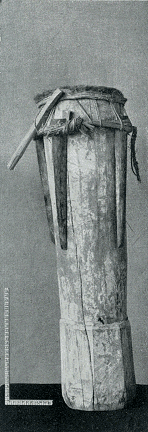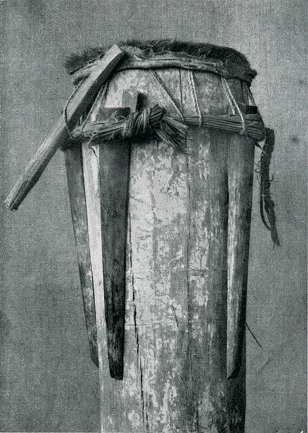Suriname folk-lore
(1936)–Melville J. Herskovits, Frances S. Herskovits–D. Musical instruments.Drums are the most important instruments in both Town and Bush, and the drummers, in these as in all Negro cultures, achieve a virtuosity of performance and an intricacy of rhythm that come of long practice. It was impossible to obtain satisfactory recordings of drumming which would reveal the complexity of these rhythm-patterns, chiefly because, lacking electrical recording apparatus, the inner rhythms which in combination give a steady beat are lost, and only the points where the notes of the several instruments coincide can be discerned. The drums have more than a musical significance in this culture. Tradition assigns to them the three-fold power of summoning the gods and the spirits of the ancestors to appear, of articulating the messages of these supernatural beings when they arrive, and of sending them back to their habitats at the end of each ceremony. Both in Town and in the Bush, the dancers who are the worshippers, | |
[pagina 521]
| |
- one of the most important expressions of worship is dancing, - face the drums and dance toward them, in recognition of the voice of the god within the instruments. Bush-Negro drums are of three types, the Apinti, the Tumao, and the Agida. The Apinti, of which examples from both Saramaka and Djuka tribes are to be seen, with a Haitian Voodoo drum of similar size, in Plate XIX, is the principal drum of the battery, as far as its function in ritual is concerned. It is the tenor drum, and the one that carries the most intricate rhythms; but, more importantly, it is also the drum that calls the Sky-gods, the powerful Kromanti spirits, and the ancestors. The attachment of the drum-head to the body shows a characteristically Gold Coast arrangement of the fastenings, and it is the only type of drum that is decorated with carved designs. Of so sacred a character are these Apinti that an example of one was acquired only after prolonged negotiations with the ancestors (through diviners), as well as the village elders. The drum spoken for was without a head, and had had to be replaced by another, yet not until the end of the second summer in the field was the decision to dispose of it reached, and the chief finally prevailed upon to send out his young men to hunt for a ‘deer’ to provide a drum-head. In the case of the Djuka specimen, the difficulty was not so great, for the village was near the rail-head, was well-to-do, and there were a number of drums available; the one acquired and which is figured was, however, the only one of the village collection that was without carving. The Tumao drum is especially dedicated to the Apuku, or spirits of the bush. When the full battery of three instruments is being played, this drum furnishes the intermediate accompanying rhythms. An example of this type is illustrated in Plates XXVI and XXVII. Inasmuch as it was the first drum acquired, it often served as a substitute for the others when drum-accompaniments to the songs were recorded. At times it was used in place of the Apinti, when the latter was not available. In actual ceremonial usage, however, when a tenor drum is missing and cannot be readily borrowed from the people of a neighboring village, the natives prefer to improvise an Apinti rather than to employ a drum of another category. As can be seen, the method of attachment of the head to the body of the drum is quite different from the attachment of the Apinti. The Agida is the bass drum of the Suriname Negroes, both in Town and in the Bush, and is the instrument which, with its low note, dominates the battery with a steady beat. With the kwakwa (to be shortly described), this beat sets the basic rhythm of the more complicated notes played by the drums of higher pitch. It is sacred to the Snake deities and is used to call them. A number of the Agida drums seen were of impressive size; the largest, found in a shrine to the Snake deities in a village on the Pikien Rio in the | |
[pagina 522]
| |
deep interior, measured more than eight feet in length, and was played as it lay on the ground. So powerful was its call, that only a few minutes after it began to sound the invocations to the Snake god, devotees from nearby villages, under possession, made their appearance.Ga naar voetnoot1 Unlike the Apinti and Tumao drums, which are played only with the hand, the Agida is played with one drum-stick, the player using his free hand to sound more intricate rhythms. All drums have at least two tones. When played near the outer edge a higher note is sounded than when the beat is struck in the center of the drum-head. All of these instruments, whatever their type, are constructed from hollowed-out logs, and, except for the largest Agida drums, each has a carved ‘foot’ on which it rests. The Apinti and Tumao drums are tilted off the ground at an angle when being played, the player usually squatting on the instrument which, in turn, rests on his heels.Ga naar voetnoot2 This makes it possible to obtain the greatest volume of sound in drumming, since there is no stoppage of the column of air inside the body as is the case when the opening at the lower end stands directly on the earth. Before playing any drum, the head is tightened, usually by driving the pegs which hold the fastenings of the head deeper into the body of the drum. With heat the skin also tightens, but we have never witnessed a drum-head tightened by means of holding it near a fire. Dances are ordinarily held during the night, when it is dampest, and it is characteristic for drummers to tune their drums at intervals during the period when they play them. Other instruments in the Bush are the kwakwa, the rattle, and the striking the ‘iron against iron’ (felu-kɔ̨-felu), an improvised triangle consisting of any two pieces of iron which are at hand. The kwakwa, which, with the iron and the Agida drum set the basic rhythm of a complex of instruments, is a low bench, with a hardwood top, beaten with two sticks by a player who squats beside it facing the dancers. However, the only real kwakwa we saw was in Paramaribo; in the Bush, the Negroes are quite content to use an old wooden box and any two pieces of wood at hand for the purpose. The rattle is the most important of the subsidiary instruments and we have seen it used alone to induce possession. It is indispensable for any religious ceremonyGa naar voetnoot3 and the rhythms it sounds vary with the spirits that are being called. In secular dances the rhythms are also governed by the song categories. A word may be said concerning those who play these instruments. The major line of specialisation is one of sex, for no woman may play | |
[pagina t.o. 522]
| |
 Plate XXVI. A Bush-Negro Tumao Drum. (Hamburg Museum, No. 30.51: 76)
| |
[pagina t.o. 523]
| |
 Plate XXVII. Detail of attachment of drum-head, Bush-Negro Tumao Drum.
| |
[pagina 523]
| |
drums, or even touch them. Belief has it that if a woman plays the drums, her breasts will grow until they reach the ground; whether or not it is this belief that gives the custom a living validity, it can be said that one never sees a woman playing one of these instruments. All men are expert at handling drums. There are those who excel as drummers and they are seen most frequently playing them, but such excellence is attributed to the favor of the gods, - ‘He has strong gods’, they say in the Bush; and in the Town, ‘It's his wɩnti’. Nevertheless, when necessary, any man can take his place in an orchestra. This is not strange, since every Bush-Negro hears the drum-rhythms from his earliest years, and before every dance one can see the small boys tuning and playing the drums. Often very young girls dance to these rhythms, while the older men listen to the drumming and correct mistakes. To illustrate how early in life a feeling for rhythm appears, we can cite our own experience on the Pikien Rio, where a child who could not have been more than two years old drummed against the side of the low box on which he was sitting, reproducing perfectly some of the Awasa dance-ryhthms, and being encouraged by the admiring comments of his parents and others who listened to him. Both women and men play the kwakwa and the rattle, but it is the women who accompany the songs with hand-clapping, and for all but the Kromanti and ancestral songs, they are the most important singers. Little need be added to what has been stated in discussing the musical instruments of the Paramaribo Negroes. Detailed photographs are given of the five drum-types found among them, and the differences in the size of the drums, and in techniques of attaching the drum-heads, are shown in the accompanying illustrationsGa naar voetnoot1. The smallest of these drum-types, and, as in the Bush the only one to be decorated and ritually the most important, is the Apinti. Of similar size but different in outline and in method of attaching the drum-head is the Podya. Next comes the intermediate-sized drum, which corresponds to the Tumao of the Bush, but which, among the coastal Negroes, is termed the Man drɔ̨, the ‘man-drum’, and still larger is the long, slender ‘ląŋga-drɔ̨’, which is played lying on its side with a drum-stick. The great drum of Town as of Bush is, once more, the Agida. As in the Bush, these instruments are supplemented with rattles, kwakwa, and iron; the sex-division in playing, and the technique of handling these various instruments follows essentially what has been described, though on occasion a woman, in the Town, will play a drumGa naar voetnoot2. |
|

